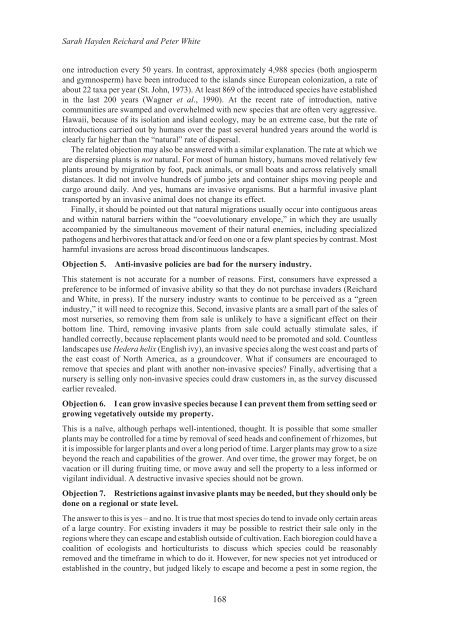Alien Species.vp - IUCN
Alien Species.vp - IUCN
Alien Species.vp - IUCN
Create successful ePaper yourself
Turn your PDF publications into a flip-book with our unique Google optimized e-Paper software.
Sarah Hayden Reichard and Peter White<br />
one introduction every 50 years. In contrast, approximately 4,988 species (both angiosperm<br />
and gymnosperm) have been introduced to the islands since European colonization, a rate of<br />
about 22 taxa per year (St. John, 1973). At least 869 of the introduced species have established<br />
in the last 200 years (Wagner et al., 1990). At the recent rate of introduction, native<br />
communities are swamped and overwhelmed with new species that are often very aggressive.<br />
Hawaii, because of its isolation and island ecology, may be an extreme case, but the rate of<br />
introductions carried out by humans over the past several hundred years around the world is<br />
clearly far higher than the “natural” rate of dispersal.<br />
The related objection may also be answered with a similar explanation. The rate at which we<br />
are dispersing plants is not natural. For most of human history, humans moved relatively few<br />
plants around by migration by foot, pack animals, or small boats and across relatively small<br />
distances. It did not involve hundreds of jumbo jets and container ships moving people and<br />
cargo around daily. And yes, humans are invasive organisms. But a harmful invasive plant<br />
transported by an invasive animal does not change its effect.<br />
Finally, it should be pointed out that natural migrations usually occur into contiguous areas<br />
and within natural barriers within the “coevolutionary envelope,” in which they are usually<br />
accompanied by the simultaneous movement of their natural enemies, including specialized<br />
pathogens and herbivores that attack and/or feed on one or a few plant species by contrast. Most<br />
harmful invasions are across broad discontinuous landscapes.<br />
Objection 5. Anti-invasive policies are bad for the nursery industry.<br />
This statement is not accurate for a number of reasons. First, consumers have expressed a<br />
preference to be informed of invasive ability so that they do not purchase invaders (Reichard<br />
and White, in press). If the nursery industry wants to continue to be perceived as a “green<br />
industry,” it will need to recognize this. Second, invasive plants are a small part of the sales of<br />
most nurseries, so removing them from sale is unlikely to have a significant effect on their<br />
bottom line. Third, removing invasive plants from sale could actually stimulate sales, if<br />
handled correctly, because replacement plants would need to be promoted and sold. Countless<br />
landscapes use Hedera helix (English ivy), an invasive species along the west coast and parts of<br />
the east coast of North America, as a groundcover. What if consumers are encouraged to<br />
remove that species and plant with another non-invasive species? Finally, advertising that a<br />
nursery is selling only non-invasive species could draw customers in, as the survey discussed<br />
earlier revealed.<br />
Objection 6. I can grow invasive species because I can prevent them from setting seed or<br />
growing vegetatively outside my property.<br />
This is a naïve, although perhaps well-intentioned, thought. It is possible that some smaller<br />
plants may be controlled for a time by removal of seed heads and confinement of rhizomes, but<br />
it is impossible for larger plants and over a long period of time. Larger plants may grow to a size<br />
beyond the reach and capabilities of the grower. And over time, the grower may forget, be on<br />
vacation or ill during fruiting time, or move away and sell the property to a less informed or<br />
vigilant individual. A destructive invasive species should not be grown.<br />
Objection 7. Restrictions against invasive plants may be needed, but they should only be<br />
done on a regional or state level.<br />
The answer to this is yes – and no. It is true that most species do tend to invade only certain areas<br />
of a large country. For existing invaders it may be possible to restrict their sale only in the<br />
regions where they can escape and establish outside of cultivation. Each bioregion could have a<br />
coalition of ecologists and horticulturists to discuss which species could be reasonably<br />
removed and the timeframe in which to do it. However, for new species not yet introduced or<br />
established in the country, but judged likely to escape and become a pest in some region, the<br />
168












